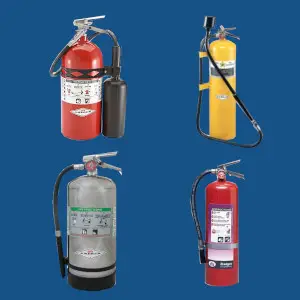Fire extinguishers are essential to your first aid fire-fighting protocols. They can make all the difference between a small, developing fire that can be easily put out or raging flames that engulf everything you hold near and dear.
It is best to be vigilant during a fire incident and know what different fire extinguisher colors mean to prevent harm or loss of property. It will help you react quickly and take the right measures to stop the fire before it grows.
Fire Extinguisher Color Coding
While your first reaction to a fire should always be to call 911, the fire would likely have spread by the time help arrives. You can stop this spread by understanding fire extinguisher color coding and the right ones to use for different circumstances. Fire extinguishers are a great way to keep the fire at bay and minimize the damage to your belongings. It can even help you save a life!
You might have noticed the different colored sections on various fire extinguishers around your residential building, office, and even the mall. But did you know the colors symbolize something significant? They guide you how use that particular extinguisher.
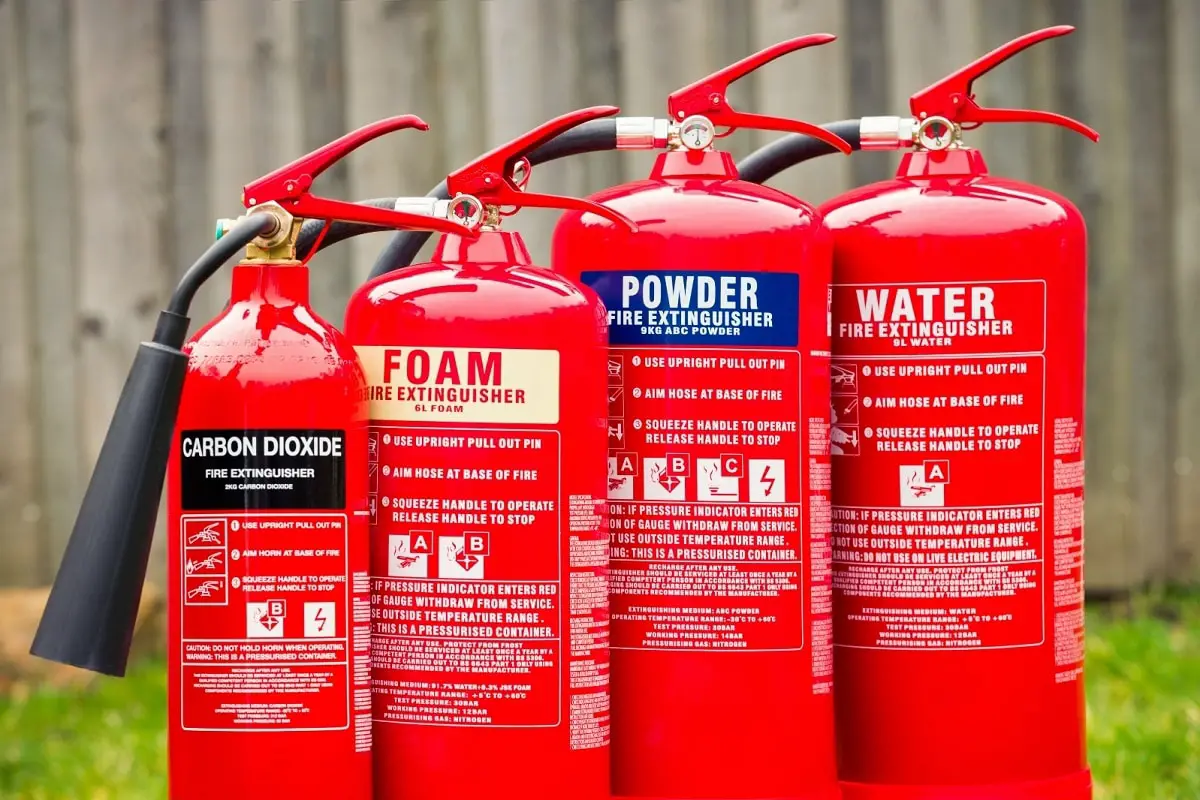
Fires are categorized into various ‘Classes’ and the fire extinguisher colors represent which Class it is designed for. Even though fires are a natural phenomenon, different items around us can light them up – literally. From electrical equipment to stovetops and cookers, various things can be the culprit causing different kinds of fires.
Therefore, before we dive into what the colors mean, you first need to identify which Class of fire you are facing. Only then will you be able to pick out the right fire extinguisher to put it out and not risk making it worse.
Class A Fires
Combustible materials or flammable solids cause Class A fires. These include fires caused by wooden furniture, paper, or clothing.
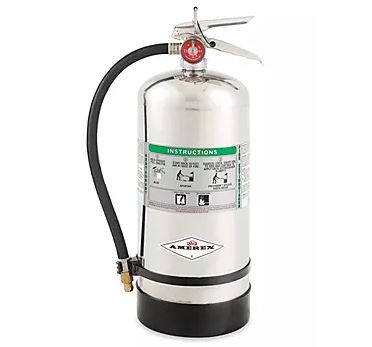
Fire extinguishers for Class A fires are often silver or aluminum-colored and use water. Class ABC dry powder extinguishers can also put out these fires and are typically red.
Here are some highly rated Class A fire extinguishers to check out:
Amerex B260 6-Liter Wet Chemical Class A K Fire Extinguisher
Amerex 240 2.5-Gallon Water Class A Fire Extinguisher
Amerex B40 2 5-pound ABC Dry Chemical Class Extinguisher with Wall Bracket
As an Amazon Associate, SelectSafety earns commissions from qualifying purchases made through links in this post.
Class B Fires
Class B fire extinguishers use CO2 to put out flammable liquids and gases. Many CO2 fire extinguishers are both Class B and C (indicated as B:C). These extinguishers are usually red with a white label.
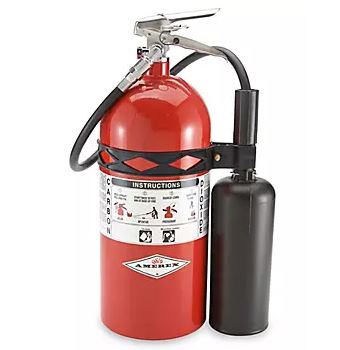
Class B fires are caused by flammable liquids. We generally assume that splashing some liquid would put out a fire; unfortunately, it can make things worse for you if the liquid is flammable.
Some common flammable liquids that require a red Class B fire extinguisher include:
- Petrol / Gasoline / Diesel
- Paint
- White spirits
- Acetone
- Alcohols (best not to grab your nearest bottle of tequila if your stove catches fire!)
Class C Fires
These are fires caused by electrical equipment. Examples of such a malfunction could be a data center computer rack overheating, your breaker box shorting out, or a spark in your HVAC wiring.
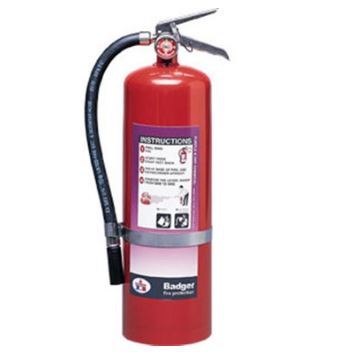
Class C fire extinguishers are usually red. Class C Purple K extinguishers are specifically designed for electrical fires and have a purple and white label.
Class D Fires
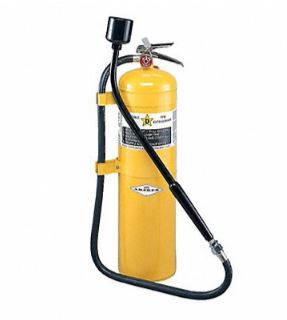
Class D fires constitute any fire that involves a combustible metal. These are metals or chemicals that catch fire quickly and burn rapidly. Common examples include potassium and magnesium.
Class D fire extinguishers are almost always yellow. They use sodium chloride (NaCl) which is an inorganic salt to put out hot-burning metals.
Class K Fires
The last category of fires, class F, refers to any fires caused by grease, cooking oils, or vegetable fats. Most kitchen or stovetop fires fall under class F.
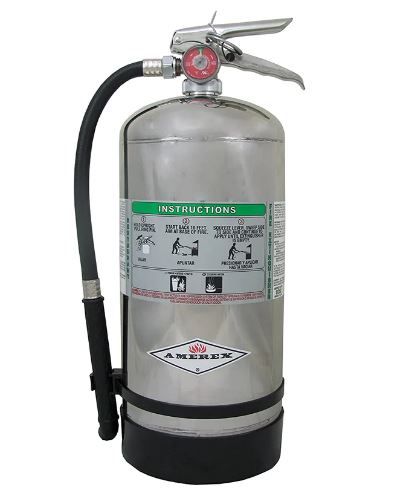
Class K fire extinguishers are silver-colored “wet chemical” extinguishers. They are required in commercial kitchens and restaurants where grease and oil fires can erupt and spread quickly.
What Do Fire Extinguisher Colors Mean?
Now that we’re clear on the different fires, we’re sure you can identify which Class you’re dealing with. This knowledge will be of immense use when picking up the right fire extinguisher color to exterminate the flames.
Let’s do an in-depth study of what the fire extinguisher color coding tells you.
Only Signal Red
The most common type of fire extinguishers is all-red. They are brightly colored, so you can locate them from far off and offer easy-access in emergencies. The signal red color shows that it is a water extinguisher. These are best for use on Class A fires.
Red and White
If your extinguisher is red and white, it stores water mist. These are meant to be used for Class A and F fires.
Red with a Cream Panel
The following fire extinguisher color coding is red with a cream panel above the operating instructions. The cream panel signifies a foam extinguisher meant to be used in Class A and B fires. It works great on paper, wood, and coal, making it the best choice for schools, warehouses, and hospitals.
However, you will need to be extra cautious not to use these in case of a kitchen or electric fire.
Red with a Blue Panel
If your electric equipment is working up and suddenly bursts into flames, you should grab a red extinguisher with a blue panel. The blue color code above the operating instructions shows that it is an ABC dry powder extinguisher which is ideal for Class A, B, and C fires.
The powder material easily puts out any inflamed liquids or gases. But, be careful not to use it in an enclosed space.
Red with a Black Panel
Black-paneled fire extinguishers are also called CO2 extinguishers. These are most commonly used in computer rooms to put out Class B or E fires.
The carbon dioxide material works best on flammable liquids and electric sparks. Every office building should have one near its server room.
Red with a Canary Yellow Panel
Lastly, if you notice a canary yellow-colored panel above your fire extinguisher’s operating instructions, you should recognize it as a wet chemical extinguisher. These are used for Class F fires in your kitchen.
Class F, or kitchen fires, are the most common kind of fire in a home. If a pan with oil is left to overheat as you grab other ingredients, it may catch fire that can spread rather quickly. Therefore, every kitchen, be it in a home, office building, or a busy restaurant, should have a wet chemical or yellow extinguisher.
Why Are Fire Extinguishers Red?
Fire extinguishers are red for the following reasons:
- Red is the color most often used to represent danger or fire.
- Red is very easy to see at a distance and especially in smoky environments (the same reason “STOP” signs and “DANGER” signs are red).
- The law requires it.
Fire extinguishers used to be different colors, each one for a different type of spray contents (foam, water, powder, etc.). Some fire extinguishers were blue or cream colored, while others were red. However, the laws in the UK and the U.S. have changed since 1997 (1997 – UK, 2000-2007 US) to mandate that fire extinguishers must be ‘signal red’ or chrome.
In the UK, fire extinguishers must match the requirements of:
This standard requires that at least 95% of the extinguishers body must be the color red. Only 5% of the total external area of the fire extinsuisher can be colored differently to identify which type it is.
In the U.S., the OSHA standard that refers to fire extinguisher colors are:
This standard declares that red shall be the basic color for identifying fire protection equipment.
Are Fire Extinguisher Colors Different in Different Countries?
Yes, they are.
Some countries abide by different rules when it comes to fire extinguisher color coding. Additionally, some places rely more on symbols than colors to signify the different fire classes that an extinguisher can be used for.
When you travel, you might find fire extinguishers in a grey/blue color instead of the typical red. These are water extinguishers best used for ordinary combustibles like paper, wood, and some plastics.
Additionally, a new kind of portable fire extinguisher is being used for a special ‘Class K’ of fires. These are specially designed for kitchen use to improve safety for you and your loved ones.
Can You Use One Color Fire Extinguisher for Another Type of Fire?
That depends on the kind of fire and the fire extinguisher color you’re using.
Some fire extinguishers can be used interchangeably, while others would lead to devastating and dangerous circumstances.
For example, a white and red extinguisher can be further used for Class B, C, and E fires. Similarly, your yellow-paneled extinguisher can put out Class A fires along with F.
However, you will need to be careful not to use a signal red extinguisher on flammable liquids, gases, or metals. Likewise, cream-paneled extinguishers can be used for Class C or D fires. It is best to stick to fire extinguisher color coding and only use it for the Class of fire it is meant to extinguish.
And Finally, Is Repainting a Fire Extinguisher Allowed?
No, it isn’t!
You might find quite a few people on the Internet giving their girlfriends pink extinguishers and painting one a gothic black for a friend. As interesting as they may look, you should keep in mind that any modifications made to a fire extinguisher color make its conformity to rules and regulations void.
This essentially means that your fire extinguisher will no longer comply with the standard fire safety code. This is because the code very clearly states that a fire extinguisher color MUST be signal red. Therefore, it would technically not be counted as a fire extinguisher anymore, despite still working as one. If you have laws or ordinances in place that state how many extinguishers should be located on your premises, they won’t count the repainted device.
All in all, it is best to leave your extinguisher in its crimson color. You can make sure it is well-maintained and cleaned regularly, so it doesn’t tamper with the look of your space, though.

